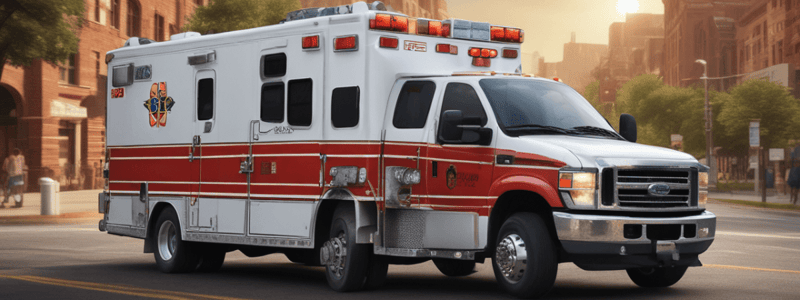Podcast
Questions and Answers
What is the preferred position for a patient on a backboard when handcuffs are applied?
What is the preferred position for a patient on a backboard when handcuffs are applied?
- Supine (correct)
- Sitting
- Lateral
- Prone
Who will accompany a restrained patient being transported to the hospital?
Who will accompany a restrained patient being transported to the hospital?
- A fire rescue battalion chief
- A hospital emergency department nurse
- A law enforcement deputy (correct)
- A paramedic team leader
What is the minimum number of paramedics required to accompany a restrained patient to the hospital?
What is the minimum number of paramedics required to accompany a restrained patient to the hospital?
- Four
- One
- Three
- Two (correct)
What should be done if a restrained patient's condition deteriorates during transport?
What should be done if a restrained patient's condition deteriorates during transport?
What type of monitoring device is used to track a restrained patient's oxygen saturation?
What type of monitoring device is used to track a restrained patient's oxygen saturation?
Who is notified immediately when a restrained patient is being transported to the hospital?
Who is notified immediately when a restrained patient is being transported to the hospital?
What is the purpose of continuously monitoring a restrained patient's airway?
What is the purpose of continuously monitoring a restrained patient's airway?
When can monitoring devices be removed from a restrained patient?
When can monitoring devices be removed from a restrained patient?
What is the primary intention of the Fire Rescue Physical Restraint Policy?
What is the primary intention of the Fire Rescue Physical Restraint Policy?
What is considered a restraint according to the policy?
What is considered a restraint according to the policy?
When may the use of a restraint and/or law enforcement assistance be necessary?
When may the use of a restraint and/or law enforcement assistance be necessary?
What type of situation may require the use of a restraint?
What type of situation may require the use of a restraint?
How should patients be positioned when using a partial or full restraint?
How should patients be positioned when using a partial or full restraint?
What is a critical consideration when using restraints according to the policy?
What is a critical consideration when using restraints according to the policy?
What is excluded from the definition of restraints in the policy?
What is excluded from the definition of restraints in the policy?
What is the purpose of continually assessing patients when using restraints?
What is the purpose of continually assessing patients when using restraints?
When is physically holding a patient necessary?
When is physically holding a patient necessary?
What should fire rescue employees avoid when attempting a restraint?
What should fire rescue employees avoid when attempting a restraint?
What should law enforcement deputies attempt to receive before physically restraining a person who refuses medical treatment?
What should law enforcement deputies attempt to receive before physically restraining a person who refuses medical treatment?
Who should be present during the restraint procedure?
Who should be present during the restraint procedure?
What is a potential risk that fire rescue employees should be aware of during the restraint process?
What is a potential risk that fire rescue employees should be aware of during the restraint process?
What type of restraint may law enforcement deputies elect to use during a restraint situation?
What type of restraint may law enforcement deputies elect to use during a restraint situation?
What is the primary goal of restraint methods?
What is the primary goal of restraint methods?
Why should the maximum number of fire rescue and law enforcement deputies necessary be utilized during manual restraint?
Why should the maximum number of fire rescue and law enforcement deputies necessary be utilized during manual restraint?
Flashcards are hidden until you start studying
Study Notes
Fire Rescue Physical Restraint Policy
- The policy aims to establish guidelines for physical and/or chemical restraint to protect patients, individuals, and personnel from harm.
Defining Restraint
- Restraint is defined as any mechanism that restricts a person's freedom of movement, physical activity, or normal access to their body.
Circumstances for Restraint
- Restraint may be necessary in clinically justified situations, when patients pose an immediate threat of harm to themselves or others, or exhibit harmful behaviors.
Methods of Restraint
- Patients will be placed supine on a long spine board or stretcher, not in prone, hog-tie, or hobble positions.
- Fire rescue employees will continually assess and ensure restraints do not restrict a patient's breathing.
Monitoring a Restrained Patient
- Patients will be monitored continuously using:
- 12 or 3 lead ECG
- Oxygen saturation with a pulse oximeter
- Blood pressure (full vital signs)
- Mental status monitoring
- Patients will be visually monitored for airway at all times.
- At least two paramedics will accompany a restrained patient to the hospital.
- Monitoring devices will remain attached until the patient is transferred to the emergency department stretcher.
Additional Guidelines
- Physically holding a patient may be necessary when employing other methods of restraint to protect the patient or others.
- Fire rescue employees will attempt to contact law enforcement for assistance when using manual restraint.
- Manual restraint will be used to limit the chance of harm to the patient or employees.
- Fire rescue employees will avoid using choke holds and placing excessive weight on the patient's back, abdomen, or chest.
- Fire rescue employees will be aware of the potential for positional asphyxia.
Restraint by Law Enforcement Deputies
- Law enforcement deputies may use handcuffs or flex cuffs during a restraint situation.
- Before physically restraining a person who refuses medical treatment, a law enforcement deputy will attempt to receive direct supervision from a physician through two-way voice communication.
Studying That Suits You
Use AI to generate personalized quizzes and flashcards to suit your learning preferences.




